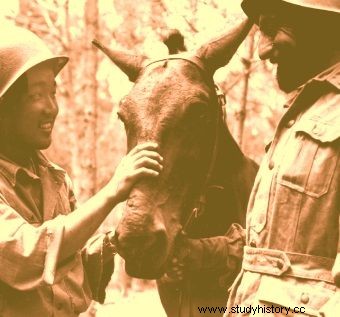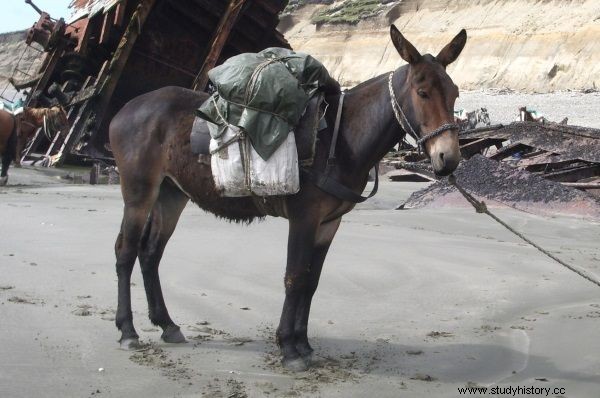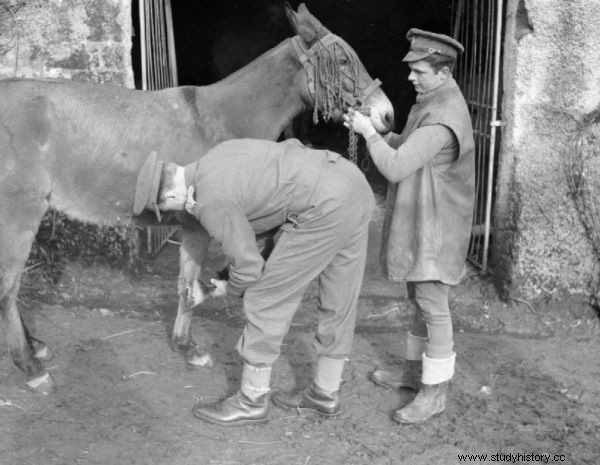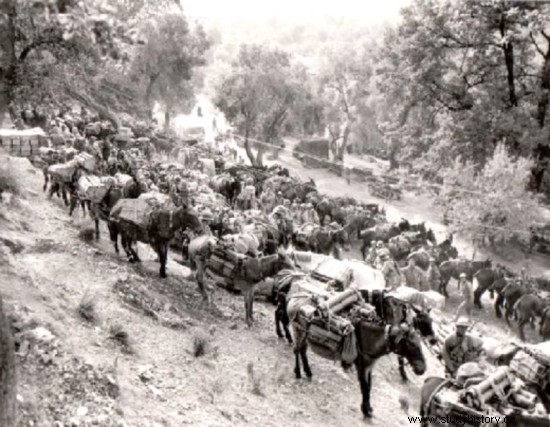The weather in Italy can be beautiful. But not in winter! The Allies found out about it at the beginning of 1944. The torrential rains turned the forest rivers into rushing rivers and the roads into quagmire. Under such conditions, the most modern Allied tracked vehicles became completely useless. Only ... mules came to the rescue of the armies conquering Monte Cassino.
Everyone can see the mule as it is (in the picture below). This animal is born as a result of cupids between a male donkey and a horse mare. Smarter than a horse and less wayward than a donkey, it also has very little nutritional requirements. This smart, four-legged beast is extremely durable and can handle narrow and winding mountain paths. No wonder then that when modern equipment was stuck in the mud, and people were struggling to climb the slopes of the mountains, the Allies decided to use mules. But there was a problem:where to get them?
"Silting up" the army
At the beginning of the Italian campaign, while still in Sicily, the Allies had only about three hundred mules. Meanwhile, military analysts, predicting the course of events, forecasted the demand for the 5th Army alone at the level of 1,300 of these stubborn animals. As the Allies began buying up animals, the Italians quickly sensed a golden deal. Initially, the US Army paid $ 80 for the mule, but as news spread, the price jumped to $ 250 almost immediately! 
In response to these speculations, a large-scale mule transfer was launched. They were imported from South Africa and from Cyprus, Lebanon and other Mediterranean countries. However, there was another problem. The faster the number of ungulate porters grew, the more problematic it became to organize provisions for them. Attempts were made to resolve the situation in a truly European way - the Joint Allied Council for Feed Supply was created . Epic. Unfortunately, it turned out to be ineffective.
The problem was solved only with the use of the already existing mule drivers, which were part of the new ally's army (on October 13, 1943, the king of Italy, Victor Emmanuel III, declared war on the Third Reich, siding with the Allies). Salmerie - The transport troops were the first Italian units to fight under the Allied command. On the eve of the struggle for Monte Cassino, the number of mules serving in the allied army reached 14,500.

Mules. Durable and fiendishly intelligent. Without them, the Allies would not have been able to cope.
Caravans of mules were constantly traversing the narrow tracks, carrying ammunition and provisions to the front, taking away the wounded and the dead. Under constant fire. Mostly at night. Many animals were killed or injured, so a field veterinary hospital was set up. Apart from helping the sick and injured mules, the healthy ones were also mutilated there. With premeditation. Before embarking on the caravan, for safety reasons, they had surgery on their vocal cords preventing them from making a characteristic roar.
Four-legged soldiers smarter than… dogs and cats
It's hard to imagine how gruesome the night caravans looked like. George Groom, a British soldier wounded at Cassino, wrote:
They had difficulty coming down the narrow path. Some of the wounded killed themselves by falling with the mules rolling down the mountain as they lost their balance. (quoted after:Peter Caddick-Adams, "Monte Cassino. Hell of ten armies", Krakow 2014).

Mule at the veterinary station. Even the best "vehicles" need an overhaul!
War reporter Ernie Pyle gives another example of the horror of animals returning from the front. In one report, he describes a mule caravan descending from Mount Sammucro writhing in the moonlight. Each of them has a corpse. Belly down. Across. The animals are accompanied by the gloomy silhouettes of soldiers.
This time, however, it was not Italians - superstitious herdsmen refused to transport the bodies of fallen soldiers, which was why the Americans had to take care of it.
We gritted our teeth because of water, mud, snow and especially loneliness, equipped only with our moral strength and our mules. (quoted after:Peter Caddick-Adams, "Monte Cassino. Hell of ten armies", Krakow 2014).
Under such conditions, a specific bond was developed between humans and animals. The more so because mules are characterized by much higher intelligence than horses . One British soldier mentioned that herdsmen treated their mules like dogs or cats. He told a heart-touching story.
Once he heard the sound of an explosion coming from the slope, followed by a scream and cry. He saw a mule with its entrails falling out desperately trying to get up and his weeping guardian hugging him and calling him by name. After a few minutes, someone killed the animal out of pity. We also know the story of an American doctor who witnessed the destruction of the entire caravan by German shelling. He argued that their keepers became utterly hysterical when they saw the injured and killed animals.
Essential Allies
The case of the 5th Transport Company seems particularly interesting. Equipped with one WW1 truck, obsolete Carcano rifles wz. 1891 (with the Italian army since 1891), 6 horses and 258 mules, she led the caravan continuously.
One of the marches lasted 24 hours. After that, only a 5-hour break was ordered and the company continued its journey.

A caravan of mules loaded with ammunition.
In recognition of the merits and fortitude of the soldiers, it received an honorary title and continued to function as the Monte Cassino Company. The importance of the mules in the Italian campaign is evidenced, in addition to the respect that their guides enjoyed, by a statement by a historian of the 45th Infantry Division. It is quoted by Peter Caddick-Adams in his book Monte Cassino. Hell of ten armies ":
Without mules our winter campaign in Italy would be impossible. On flat ground, motor vehicles got stuck in the mud as if idling.
The worst steep slopes could only be overcome by people who climbed several centimeters with each step, carrying boxes of food rations or water in slings on their backs.
Between these extremes, there were miles of trails where the mules had become an annoying necessity.
Therefore, it is safe to put forward the thesis that without the use of mules the Allies would not have won at Monte Cassino. As a result, it would not have been possible to cross Gustav's line, oust the Germans and enter Rome in early June 1944. And even a Polish blood sacrifice would not be enough.
